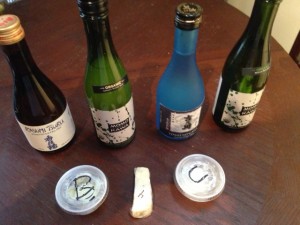Sake and Cheese Pairing
Sake One is an Oregon based sake producer and importer. They make 3 sakes in the United States for the Momokawa, G Saké, and the fruit-infused Moonstone brands at their own kura in Forest Grove, Oregon. SakéOne is focused on expanding the enjoyment of premium saké in the United States and they not only make their own sakes but also import Japanese sakes.
Sake is made from high starch rice. The rice is milled polished and fermented. The higher mill on the rice the lighter and more aromatic the sake is in flavor. Yeast and water are added to the rice and it is fermented pressed pastureized and then either filtered or unfiltered. Sake is generally meant to be consumed young although there are some sakes made to be aged.
Sake is meant to enhance the food you eat it with and in Japan it is often enjoyed with bar snacks, sushi or noodles. I was recently invited to participate in sake and cheese tasting put on by Charles Communications Sake One and Marin French Cheese.
Sake and cheese pair well together because they both contain lactic and amino acids. For cheeses, lactic acid contributes to aromas and flavors and acts as an antimicrobial barrier. In sake, lactic acid often imparts a creamy, buttery taste and aroma. Amino acids, found both in sake and cheese provide umami a richness and savory quality. This his makes them pair well and compliment each other.
Momokawa Organic Junmai Ginjo (SRP $14/750ml) with Marin French Petite Breakfast Brie This sake is made with organic rice grown in Central Valley. It has aromatic fruit flavors of lychee & melon. The cheese came about during Gold Rush when there was an egg shortage and a need for food for breakfast. The cheese has no age to it and tastes fresh and tangy with a nice creamy texture that complements the fruitness of the sake.
Momokawa Organic Nigori (SRP $14/750ml) with Laura Chenel’s Chévre Nigori
This sake made in the Nigori style is pressed at the end of fermentation separating the rice from the liquid but some of the rice is left in making it sweeter than Junmai. Laura Chenel’s Chevre is the first goat cheese introduced to the US in the late 70’s. Alice Waters put bread crumbs on the cheese and placed it on a bed of greens which was very innovative at the time. This pairing works well because it is creamy cheese with creamy sake
Kasumi Tsuru Kimoto Extra Dry (SRP $27.00/720ml) with Laura Chenel’s Ash-rinded Buchette Kimoto sake is mashed continually in cold temps for 2 weeks in a cold tank to naturally make the acids as opposed to just adding them which is what is more commonly done, this process provides rich earthy big umami flavors. The cheese is an aged goat cheese that comes in a little log with a coating of vegetable ash which mellows the acidity of the aged cheese making the flavor more delicate and better for food pairing. It is rich and savory with a funkiness that pairs well with the umami flavors of the Kimoto sake.
Yoshinogawa Winter Warrior Junmai Ginjo (SRP $27.00/750ml) with Rogue River Blue Cheese This sake comes from a 19th generation sake maker in Japan. It is tropical & sweet with anise flavors on the finish. The cheese comes from Oregon and it has been around since the 50’s and is a classic blue cheese. The pairing provides a nice sweet salty contrast.
If you are not familiar with sake I suggest you buy some small bottles and give it a try to see which style you like. If you want to pair it with cheese consider the above pairings or talk to your local cheesemonger and see what they might suggest. If instead you want to be more traditional, consider pairing your sake with sushi, udon noodles or other traditional Japanese foods you like or go to a local Japanese restaurant and try some of the sakes on their menu, many offer sake tasting flights and some even offer pairings
Thank you to Sake One, Charles Communications and Marin French Cheese for an interesting introduction into cheese and sake pairing.
Tags: Charles Communications, Kasumi Tsuru Kimoto Extra Dry, Laura Chenel’s Ash-rinded Buchette, Laura Chenel’s Chévre Nigori, Marin French Cheese, Marin French Petite Breakfast Brie, Momokawa Organic Junmai Ginjo, Momokawa Organic Nigori, Rogue River Blue Cheese, Sake One, Yoshinogawa Winter Warrior Junmai Ginjo

